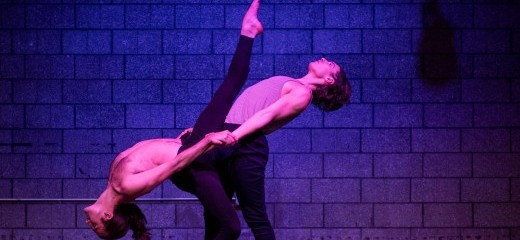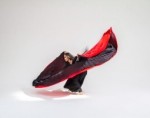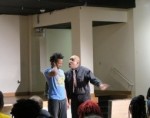
Erotic Divine, Born of Structural Space
by Jenna Horton
Writers of dance have told me, “write what you see.”
Well, what about dance that choreographs what you can’t see?
What about dance that cares about order, sequence, and structure because it cares about what movement emits?
Yes.
Emits.
Writing about Tere O’Connor’s dance is like writing about gas emissions,
Northern Lights, love, heat coming off a car.
It’s about what you see,
but it’s also not.
An oblong square platform spatially interrupts New York’s Joyce Theater. Fracturing the usual proscenium orientation, it allows viewing from four sides. Not-quite-violet light bounces off its white floor, emanating a quasi-sacred anticipatory glow. Tere O’Connor, like the other four choreographers curated by Lar Lubovitch for the NY Quadrille, has been tasked to create a modern variation of the eighteenth-century dance form from which the series gets its name.
Brouhaha aside, the stage transformation (the first in the Joyce’s 35-year history) shifts what is possible. Sitting around a designated stage is different that sitting in front of one. Sitting with other viewers across and to either side of me heightens my role as watcher. Does it feel more intimate? Not quite. Perhaps more social. Porous? Definitely. More vulnerable for those about to enter. No wall to hide one’s back.
Silas Riener and Michael Ingle step into this expansive exposure with grace. They allow us to look—at their lips, cheekbones, jaws, stunning flanks, long hair, pointed feet. No denial, irony, or evasion. No pretending not to notice. They stand inside their dancer bodies unashamed, dedicated to the power they emanate. The choreographer, doesn’t buck, fold, or joke either. Undersweet [1] steps squarely forward to meet the quadrille’s call.
The initial choreography—courtly, kaleidoscopic, Celtic—begins to attune us, almost subconsciously, to spaces between. Riener and Ingle prance around the perimeter, activating the expansive distance between them. Tracing the outside edges, they gather our stares before arriving in a closed position with upper bodies in opposing epaulment. They waltz as if buoyed by a delicate wind tunnel. Like folding egg whites into batter, the dance starts to invaginate our attention. The pair’s parallels, crisscrosses, and tender promenades generate a subtle electric charge between them, in the room, in my perception—an activated circuit from this point forward. The sensations reawaken a chapter of Anna Karenina I haven’t recalled in years. The dance has begun a larger trajectory of braiding me psychically inward—into it and into myself, simultaneously.
Ingle and Riener throw light on invisible architecture in my mind: corners of an ephemeral maze, a diagonal across a wide-open field, a high, narrow corridor in a bathhouse. They use the quadrille’s jeté, chassé, croisé to speckle the stage with exquisitely pointed feet. They dapple the air with angular, supple knees. Ballet technique is readily available to both dancers, although it shows more prominently on Riener’s figure, lean and chiseled. This vocabulary, committed to a particular ideal of beauty, line, and precision, can be devilishly hypnotic. Perhaps it’s something about the human ability to fit into a geometric and agreed-upon public form.
Commitment to this tension—between the quadrille’s public formality and something more tender, private, specific—becomes the piece’s engine. The quadrille serves both as coat and protection for the thing beneath coat—a tender jest saying, “I am, not entirely, what I seem.” And here’s where O’Connor succeeds at depth where convention might fail, or worse, become victim of its own tyranny. Rather than pursue the ideal of a polished and unified front for comfort or achievement’s sake, O’Connor nurtures the tension between unison and difference, giving birth to something more variegated, complex, and shifting.
The dancers incorporate this ethos beautifully, maintaining sensitivity to the boundary between them. They touch when not touching, when conjoined they maintain individual presence. Their torsos speak supply. Riener’s legs open in a split towards the sky. Ingle drifts lightly across his groin. The relationship is intimate, like being in love, when attention both telescopes inward and outward, becomes broader and more detailed.
They are two men, dancers, both with long hair. My brain categorizes sameness, registers pleasure in homos. And yet. Riener is shirtless with tight textured brown pants reaching just below his calve; Ingle wears steely grey t-shirt and exercise shorts. Riener’s energy echoes his musculature: defined, gloriously self-possessed, pristine; Ingle’s too: supple, strong, warm. Riener’s taut pants hug his taut legs; Ingle’s t-shirt drapes off his relaxed shoulders. Difference accentuated, similarity tugging, sensuality blooming between.
The dance shape shifts. Rhythmic ribbiting and croaks briefly interrupts the baroque opera; although Riener’s and Ingle’s movement remains similar, a Zamboni-like digitized Egyptian frog jig momentarily possesses the court dance. Later, counting down from 22, Ingle and Riener momentarily become two boys playing a game. In a stunning image, Ingle becomes a spoke, spinning Riener as the extension, with light flashing between the V of his legs, creating the uncanny sensation of the ceiling having opened. A climax? A portal? An abduction?
To tell you where else I went during the dance is near impossible—horse hooves on pavement and on soft dirt, scabs, gargoyles in the corners, skirt against skin against wheat. Wisps of hair like twigs, a large pink orb, a twitch of a deer’s ear, adolescent sex, a cavernous bathhouse with old men in the distance, the possibility of planetary conjunction. Greg. These are mere undulations in a larger experience that has both nothing and something to do with them.
In Undersweet’s universe, power is not rendered by loudness or celebrity, by knowing what’s hip, what’s done, or by regurgitating the oldest or the newest taste. The dance dedicates rigorous attention to the unfolding of now, trimmed of nostalgic fat. It gives life to romantic presence as I have experienced it, as I always want it to be, as I yearn for again: impossibly queer, thickly charged, dedicated to a moving life all its own.
Head to head at the center of the stage, Riener and Ingle lie face down, creating a line that bifurcates the oblong square at its most interior. Still with us, yet no longer facing us. Still together, yet not with their faces. Coming to rest, they delicately lace together in a diamond shape, arms extending beyond the head of the other just across. A sense of mutual canopy. Their hands, palms down, drift down to find a temporary home at the nape of their partner’s neck. Light telescopes down and disappears.
My throat twinges. “Don’t go,” I whisper. “Come back.”
Undersweet, NY Quadrille, Tere O’Connor Dance, The Joyce Theatre, October 4-9, https://www.joyce.org/performances/tere-oconnor-dance
[1] Transcendental Daughter, also choreographed by O’Connor, followed as the program’s second offering. I found it less developed, more ethereal, and while it seemed to be very curious about movement in a thirty-forty percent register (this is not a jab), I failed to recalibrate my senses to it after Undersweet. I have chosen not to write about it.
By Jenna Horton
November 9, 2016







